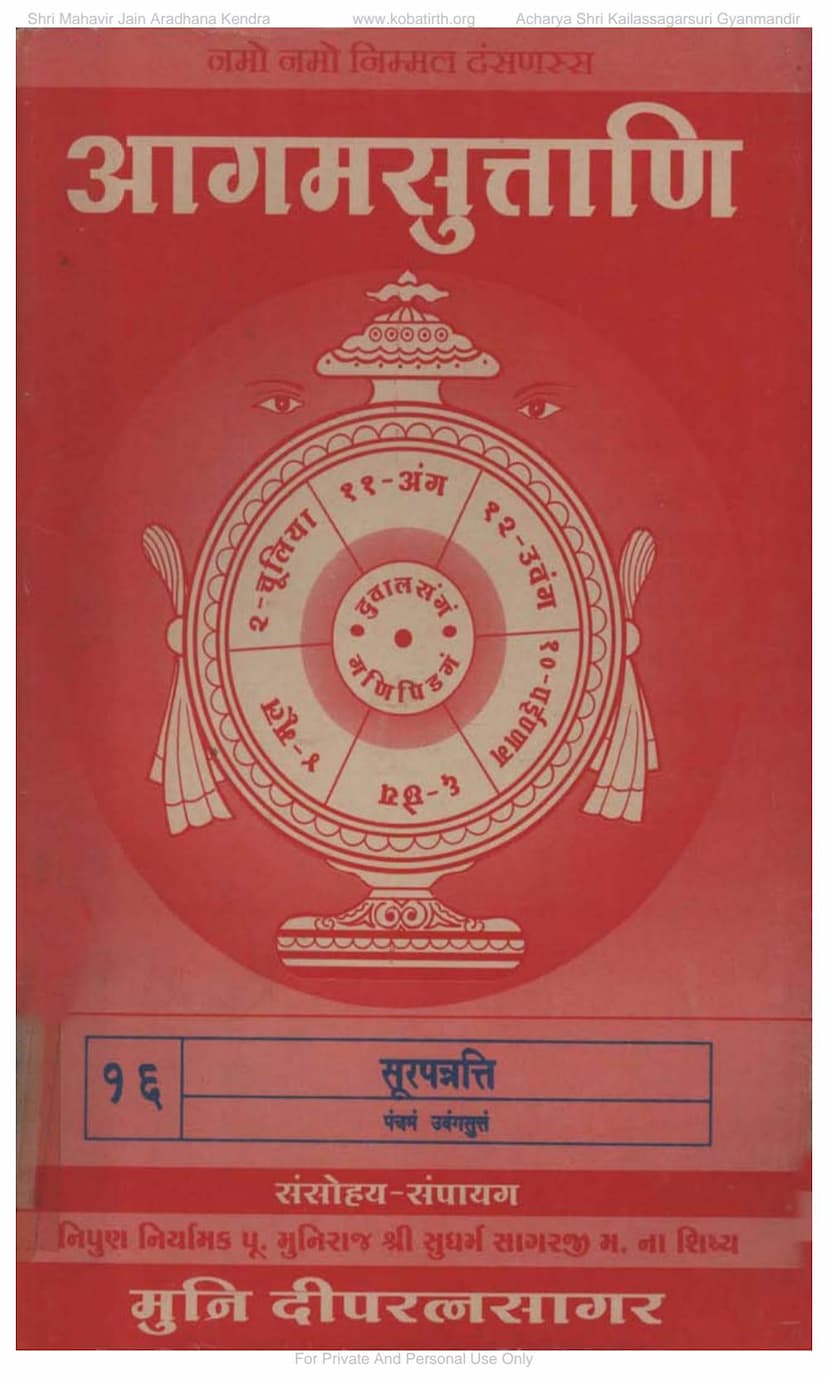Agam 16 Surapannatti Uvangsutt 05 Moolam
Added to library: September 1, 2025

Summary
Here's a comprehensive summary of the Jain text "Agam 16 Surapannatti Uvangsutt 05 Moolam" based on the provided pages:
Title: Agam 16 Surapannatti Uvangsutt 05 Moolam Author(s): Dipratnasagar, Deepratnasagar Publisher: Agam Shrut Prakashan Catalog Link: https://jainqq.org/explore/009742/1
Overall Nature of the Text:
This text is part of a larger collection of Jain Agam literature. Based on the title and the content, it appears to be the fifth Upanga Sutra within the Agam canon, specifically focusing on astronomical and calendrical calculations related to the sun. The "Moolam" indicates it's the root or original text.
Key Sections and Content:
The document begins with introductory pages, including acknowledgments of financial contributors and patrons who have supported the publication of these Agamic texts. The core of the text consists of detailed explanations and discussions about the movements, calculations, and properties of celestial bodies, primarily the sun, and to a lesser extent, the moon and stars.
The text is structured into various "Pahuda" (chapters or sections), further divided into "Pahuda Pahuda" (sub-sections). The detailed breakdown, especially from Page 7 onwards, reveals a systematic approach to astronomical knowledge within Jainism.
Key Themes and Concepts:
- Astronomy and Cosmology: The primary focus is on the sun (Surya) and its movements. It delves into the complex calculations of its path, positions, and the resulting lengths of days and nights throughout the year.
- Calendrical Calculations: The text meticulously details how to determine the time of year based on the sun's position, including the durations of seasons, months, and years.
- Celestial Cycles and Cycles: It discusses the cycles of the sun, moon, and stars, providing specific numbers and calculations for their movements and appearances.
- Geographical and Cosmological Framework: References to Jambudvipa (a continent in Jain cosmology) and other geographical features indicate a framework for understanding the universe within the Jain perspective.
- Mathematical and Astronomical Precision: The text demonstrates a high degree of precision in its calculations, using fractions and specific units of measurement (like "muhurtta," "yojana," "angula," etc.) to describe celestial phenomena.
- Structure and Organization: The text is highly organized, with a clear numbering system for sutras and verses (Gaha). The detailed listing of the contents of each "Pahuda" suggests a structured educational or explanatory purpose.
- Devotion and Acknowledgement: The introductory pages highlight the devotional aspect, acknowledging the gurus and benefactors who made the publication possible, and offering salutations to Jain Tirthankaras and spiritual leaders.
- Specific Astronomical Details Mentioned:
- The Sun's Path: Detailed calculations of how the sun moves through various "mandals" (circles or regions) and how its path influences day and night lengths.
- Half-Mandala Structures: Discussion of the sun's movement within southern and northern half-circle paths.
- Inter-Solar Distances: Calculations of the distances between the sun and other celestial bodies.
- The Sun's Movement and Light: Explanations of how the sun's position affects the illumination and duration of days and nights, including specific timings in "muhurttas."
- Shapes and Sizes of Celestial Bodies: Descriptions of the shapes and dimensions of the sun, moon, and their orbits.
- The Nature of Celestial Bodies: Discussions on whether they are solid, hollow, or possess other characteristics.
- The Time of Eclipses: Calculations and descriptions related to eclipses.
- The Influence of Celestial Bodies: Mention of how the positions of the sun and moon affect human experiences and the world.
- The Role of Rahu: Explanation of Rahu as a celestial entity that influences eclipses.
- The Astrological Significance of Nakshatras: Detailed information about the 27 lunar mansions (Nakshatras), their associations with gods, their timings, and their relative positions with the moon and sun.
- The Luminosity of Celestial Bodies: Discussions on how the sun and moon illuminate the world.
- The Measurement of Time: Divisions of time such as muhurttas, days, nights, months, and years.
In essence, this Jain Agam text, "Surapannatti," provides a detailed and mathematically precise framework for understanding the movements and interactions of the sun and other celestial bodies within the Jain cosmological system. It demonstrates a sophisticated understanding of astronomy and timekeeping as integral to Jain spiritual and philosophical teachings.